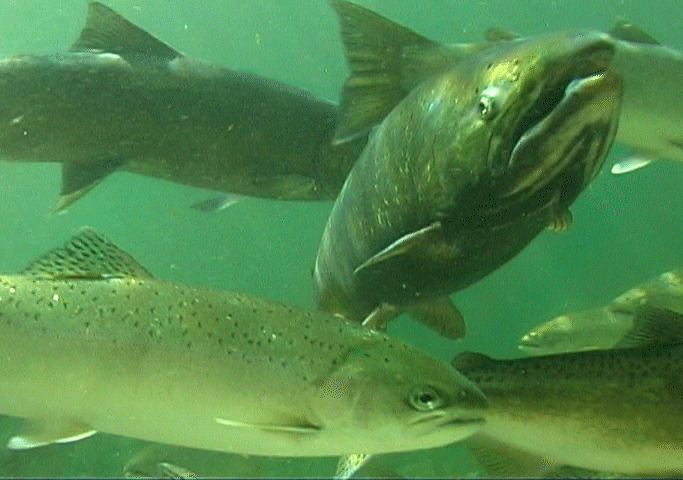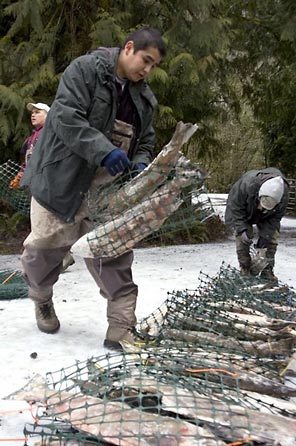|
|
|
|
...
International
Herald
Tribune
SACRAMENTO: Where did they go? The Chinook salmon that swim upstream to spawn in the fall, the most robust run in the Sacramento River, have disappeared. The almost complete collapse of the richest and most dependable source of Chinook salmon south of Alaska left gloomy fisheries experts struggling for reliable explanations — and coming up dry. Whatever the cause, there was widespread agreement among those attending a five-day meeting of the Pacific Fisheries Management Council here last week that the regional $150 million fishery, which usually opens for the four-month season on May 1, is almost certain to remain closed this year from northern Oregon to the Mexican border. A final decision on salmon fishing in the area is expected next month. As a result, Chinook, or king salmon, the most prized species of Pacific wild salmon, will be hard to come by until the Alaskan season opens in July. Even then, wild Chinook are likely to be very expensive in markets and restaurants nationwide. "It's unprecedented that this fishery is in this kind of shape," said Donald McIsaac, executive director of the council, which is organized under the auspices of the Commerce Department. Source Article and rest of story... International Herald Tribune |
|
| Bringing the
Elwha River back
to life
By Mark Yuasa
Almost 100 years ago the Elwha River on the northern Olympic Coast had wild chinook salmon topping 100 pounds. Then came the modern industrial era, and in 1913 this once pristine river that hosted all five salmon species was blocked by the first of two hydroelectric dams, leaving no path for fish migration to the upper 38 miles of mainstem and more than 30 miles of tributary habitat. Along with the monster kings, other salmon populations above the Elwha dams have long since vanished, but a minuscule salmon run still knocks on the base of the lower dam each year. State Fish and Wildlife biologists calculate that fewer than 5,000 wild fish return each year, which is 1.3 percent of its historic level. As part of the Elwha River habitat restoration plan, the Lower Elwha Klallam tribal staff placed more than 600 frozen, spawned-out coho in the upper river back in January. The carcasses came from the 2006-07 returns to the tribe's hatchery. Green mesh bags, holding two coho carcasses each, were staked into streambeds above one of the river's two fish-blocking dams. The bags will be removed once the fish decompose. "We are looking at how it affects the freshwater food web, and is it stimulating algae growth and creating food for invertebrates," said Sarah Morley, the National Oceanic and Atmospheric research ecologist in Seattle who developed the project. "It [salmon carcass placement] is a new approach to restoration that has been overlooked in the past, and this subsidizes nutrients that is lacking from the system." These spawned-out carcasses are a major contributor to the river's food chain web, including fish and other wildlife critters and aquatic bugs. They also generate nutrients like nitrates, carbon and phosphorus in the river. "In the Elwha salmon haven't been in the upper river for almost 100 years, and the river is relatively infertile, so this is an important start to see how the river responds," said Mike McHenry, a tribal habitat program manager. "The study will give us an idea on how the whole aquatic ecosystem works with this sort of stimulation." Fisheries officials will investigate the benefits of these carcasses to the river environment before dams are removed after 2010. This type of placement of salmon carcasses in other Puget Sound rivers and creeks has played an important role in enhancing watersheds and restoration of salmon populations. The 108-foot Elwha Dam and 210-foot Glines Canyon Dam were built to provide hydroelectric power to Port Angeles. The dams didn't have fish ladders, preventing salmon from migrating upriver to spawn. The dams are owned by the federal government, and Olympic National Park is the leader in removing them. The total cost of the project is estimated at $308 million. SOURCE: |
|
| Bring the
Salmon Home: Klamath
Dams
Average number of adult wild salmon
returning to the
Klamath River Each Year: 880,000
Klamath Dams Have to Go for the
Klamath Salmon:
Dams Hurt Communities and Fish
Spring Chinook and Dams
Dams Create Toxic Algae
Pacific Power is Not Green
For more information about the
Klamath Dams see:
BRING
THE
SALMON HOME
|
|
| FAIR USE NOTICE: This page contains copyrighted material the use of which has not been specifically authorized by the copyright owner. Pegasus Research Consortium distributes this material without profit to those who have expressed a prior interest in receiving the included information for research and educational purposes. We believe this constitutes a fair use of any such copyrighted material as provided for in 17 U.S.C § 107. If you wish to use copyrighted material from this site for purposes of your own that go beyond fair use, you must obtain permission from the copyright owner. | |
|
|


